11th Installment: “An ‘Uncommon American’ Influences on an ‘Uncommon Academic'”
"Conversations With and About Mike"
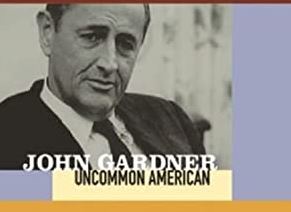
John Gardner: Uncommon American: 2001 PBS documentary
After reading Installment 10, “Let’s Get Personal, ‘From Fraternity to Paternity,’” John Fensterwald, Editor-At-Large of EdSource, California’s go-to publication for education news, observed, “Great stuff in your latest chapter. I had no idea about Mike’s relationship with John Gardner. I would have asked about that years ago. Congrats on eliciting all this good stuff.” 1
So that’s the focus of this and the next installment: Mike’s relationship with John Gardner. In this one, we explore Gardner’s influences on Mike from their work together in D.C. and even more profoundly over time. The next installment treats in more depth how that relationship developed and how a combination of circumstances, including Mike’s wife, Wendy’s role, helped the two men carve a powerful personal path and significant mutual accomplishments.
The title of a 2001 PBS documentary presenting the life and legacy of John Gardner calls him an “Uncommon American.” As documented in this unfolding biography project, we can agree that Mike Kirst merits a similar laudatory moniker: “Uncommon Academic.”
“Uncommon Academic” In What Ways?
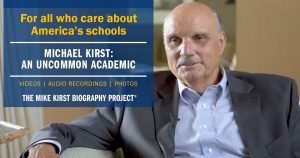 In the first episode of “Conversations With and About Mike,” we heard Governor Jerry Brown, after his 40+ years with Mike serving as his education expert, confidante, and State Board of Education President, tell us, “it’s unusual for an academic and an elected politician to work so amiably and so closely together.” 2 (emphasis added)
In the first episode of “Conversations With and About Mike,” we heard Governor Jerry Brown, after his 40+ years with Mike serving as his education expert, confidante, and State Board of Education President, tell us, “it’s unusual for an academic and an elected politician to work so amiably and so closely together.” 2 (emphasis added)
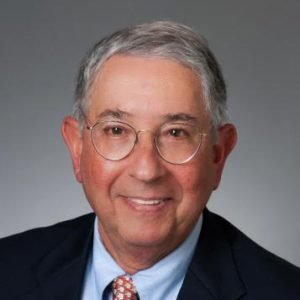
Chester Finn, one of America’s most insightful education commentators and former Legislative Director for U.S. Senator Daniel P. Moynihan, likens Mike Kirst to the senator in that he effectively had “a foot in the academic world and a foot in the policy world” (as did Henry Kissinger “and a handful of others—but not a very big handful”). He tells us that is “a distinguishing characteristic” of Mike, “and not that common of one.”
Audio Clip 1: Finn on one of Mike’s “distinguishing characteristics” 3
James Guthrie, the co-author of scores of publications with Mike in the early 1980s and co-founder with Mike and Gerald Hayward of PACE (Policy Analysis for California Education), California’s long-time education think tank, emphasizes this as well:
Audio Clip 2: Guthrie: “Mike is the most insightful academic I’ve ever seen about political matters…instincts of a master juggler.” 4
Citing Mike’s work in both Florida and California, Guthrie emphasizes Mike’s “political genius” and ability to be an effective partner with a “political champion,” speaking a language that advances their work together and does not “bore the be-gabbers out of them.”
Mike’s beginnings with John Gardner through The White House Fellows
“Gardner’s Zeal to Cultivate Leaders”
In Uncommon American, the PBS documentary about John Gardner, he speaks of his passion for the White House Fellows program, which he founded, and highlights its goals and accomplishments around cultivating leaders for all areas of service to America. Let’s listen in:
Video Clip 1: John Gardner on the White House Fellows
Both Gardner and alums of the program 35 years later emphasize the meaningfulness of the experience.
In Installment 9, “A Young Dr. Michael Kirst Goes To Washington,” we heard Mike speak of his work as Associate Director of the White House Fellows as he led its education component, geared to connecting the Fellows to the nation’s thought leaders, not only in D.C. but locally—so important to Gardner throughout his life and writings.
Mike’s Take on Gardner with the Fellows and Beyond
In a 2018 interview with Mike, Nancy Mancini of the John Gardner Legacy Oral History Project asked Mike to describe Gardner’s interactions with the Fellows during these earliest years of the program.
Audio Clip 3: Mike on the Fellows and Gardner: “They were very, very attached to him…. He was “very much a figure.” 5
We hear Mike speak of dinners and extensive “personal contact and bonding.” He describes Gardner as “very much a figure” to the Fellows; “he met with many fellows personally to give them personal advice…followed their careers” and “so they were very, very attached to him.”
Mike as “Very Much a Figure”
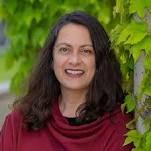
Andrea Venezia: Photo courtesy of Calif. State Univ. – Sacramento
Many of Mike’s colleagues—graduate students, academics, and co-authors—express similar sentiments about him and his role in their thinking. For just one example, let’s listen to Andrea Venezia, Executive Director of the Education Insights Center (EdInsights) at California State University – Sacramento, who describes Mike’s insightful and meaningful observations with her as she began her professional trajectory and as she and Mike wrote extensively together:
Audio Clip 4: Venezia on “the stuff with Mike that goes beyond the professional realm” 6
Elsewhere Venezia reports on her experiences as she sought Mike’s advice about her doctoral studies, her dissertation, their co-authorship of numerous publications, and pathbreaking research establishing the “K–16” policy movement. 7 But what she emphasizes repeatedly is Mike’s influence “beyond the professional realm.”
Nancy Mancini asked Mike in this interview for his observations of Gardner’s leadership style:
Audio Clip 5: Mike on Gardner’s style in accomplishing things 8
Mike describes Gardner’s “obvious gravitas”; “aura of great respect and wisdom”; and “thoughtful, deliberate, [and] conceptual way.” He notes that Gardner’s style was definitely not “domineering” or “controlling”; rather, Mike saw in Gardner “a more soft style of leadership” and “working through people rather than ‘I’ve got a bunch of ideas, and I’m going to get [others] to go along with them,'” concluding that Gardner was “collegial” and “open.”
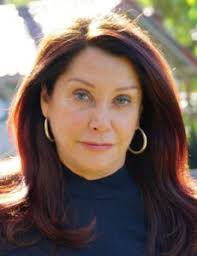
Trish Boyd Williams: Photo courtesy of EdSource.
Trish Boyd Williams, the former Executive Director of EdSource and then Vice-President of the California State Board of Education, recruited by Mike, and eventual led on policy-making about the state’s burgeoning charter school arena as well as the Board’s adoption of the first-ever statewide K–12 computer science standards, has also spoken of Mike’s way of delegating important work to others and supporting their progress. And she also notes Mike’s energy and commitment to action:
Audio Clip 6: “Wing-woman Williams on Kirst: “He was committed to…getting everything in motion.” 9
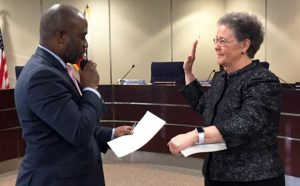
Linda Darling-Hammond being sworn in as California Education State Board President in 2019. Photo courtesy of EdSource; photo by Janet Weeks/SBE.
Linda Darling-Hammond comments as well on Mike’s energy and style of working through others. Darling-Hammond is the current president of California’s State Board of Education. Let’s listen in:
Audio Clip 7: Mike and Linda’s hour-long “Power and Policy Walks” 10
You may have read just a few weeks ago in the November 8 New York Times pulled herself out of possible consideration to serve as President-Elect Biden’s Secretary of Education, saying that “My commitment to Gov. Newsom and the California [education] agenda that we are pursuing through the State Board of Education are paramount to me.” This was the agenda Mike put into motion with Governor Brown for the eight years prior to the start of Linda’s term as the board’s president.
Much of what Darling-Hammond says parallels what Mike and others have found most admirable about Gardner:
- “He is really focused on ‘let’s get this thing done'”; “he’s brilliant in his way of conceptualizing”; “he’ll put people in charge”; and “I’m always scurrying to try to keep up.”
- “He has a fast brain” (or, as we have heard before, that he’s the smartest person in the room but humble about it); and when you’re working with policymakers and politicians, “you’ve got to think about how to make [an] idea accessible.”
But she adds important details—or puts her own twist—on what makes Mike an “uncommon academic”…in particular what she (and others) note as one of his skills: being a master of “brokering” ideas, for example, by “float[ing] a trial balloon of ideas and see[ing] what happens to them”; by “adjust[ing] his thinking based on what the political winds as well as what his ideas are”; and often by having “to wait for your idea to be implemented because it’s not ripe yet.”
She shares the observations of Jim Guthrie and Chester Finn: “what a lot of academics don’t really understand is that if you really want to get things done in the world, it’s not enough to have a good idea and have it published in a journal. You have [to know how] to work through the politics, the constraints, the opposing perspectives.”
Gardner and Kirst: Three Key Thematic Similarities
Video Clip 2: The “Uncommon American” John Gardner through others’ eyes
Ramona Edlin,past president of the Urban Coalition.
We hear in this PBS video clip from General Colin Powell: “John Gardner is a great American who taught Americans leadership and civic responsibility for his entire life.”
Richard Dreyfuss adds, “This is high praise for a man of whom you may know little or nothing at all.”
Then an unnamed woman wonders “…why John Gardner is not a household name.”
Others quickly chime in to build on Powell’s praise: Fred Wertheimer (former president of Common Cause, founded by Gardner); Ramona Edelin (former president of the Urban Coalition, also founded by Gardner); and Bill Bradley (former U.S. Senator and basketball legend):
Wertheimer: “Well, he never turned the camera on himself.” Edelin: “Yes, he was the glue, not the glitz!” Bradley: “Maybe we know so little about him because it has taken PBS this long to do a film about him….”
Three important tag lines support the conclusion that Gardner was an “uncommon American”
- “He does not turn the camera on himself.”
- “He is the glue, not the glitz.”
- “He has taught and lived civic responsibility for his entire life.”
And clearly, these taglines (and other similarities) describe Mike Kirst as well, supporting our naming him an “uncommon academic.”
Up Next
So how did this critical relationship between Mike and Gardner more fully develop later? That’s an important story to understand. We’ll find that, as usual, Mike does “turn the camera on himself.”
Our next installment picks up with how a combination of circumstances, including particularly the relationship that Mike’s wife Wendy had with Gardner, underlie and influence the bonds that developed between these two men.
Join us soon for Installment 12!
Editor’s Note: The Appendix for “Conversations With and About Mike” contains transcripts for the recorded audio and video clips. To view the Audio Transcripts go to this page >
Footnotes
- Email correspondence from John Fensterwald, September 10, 2020.
- Jerry Brown interview with the author, January 14, 2019.
- Chester Finn interview with the author, October 25, 2018.
- James Guthrie interview with the author, August 23, 2018.
- Mike Kirst interview with Nancy Mancini, May 3, 2018, for the John W. Gardner Legacy Oral History Project (SC1355). Department of Special Collections & University Archives, Stanford Libraries, Stanford, Calif. https://purl.stanford.edu/fb149yr2480
- Andrea Venezia interview with the Author, September 19, 2018.
- Andrea Venezia interviews with the Author, September 19, 2018, and
October 2, 2018. - 8Mike Kirst interview with Nancy Mancini, May 3, 2018, for the John W. Gardner Legacy Oral History (SC1355). Department of Special Collections & University Archives, Stanford Libraries, Stanford, Calif.
https://purl.stanford.edu/fb149yr2480 - Trish Williams interview with the author, July 24, 2018.
- Linda Darling-Hammond interview with the author, September 20, 2018.
